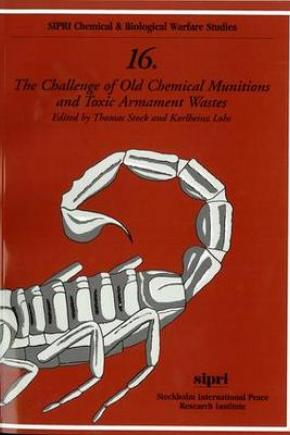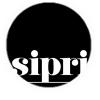The Challenge of Old Chemical Munitions and Toxic Armament Wastes
In this study, sponsored by the Volkswagen Foundation, 20 experts from 10 countries analyse the feasibility of detecting, locating, handling, transporting, storing and disposing of old chemical munitions and toxic armament wastes. Their history, physical and chemical properties, options for dealing with them and data on destruction technology are presented. Chemical warfare agents and chemical munitions were buried or dumped at sea in Europe after World Wars I and II. Knowledge about their effect on people and the environment is limited, and there have been accidents involving old chemical munitions—not least those in which fishermen in the Baltic Sea have been injured. Many of the issues related to old chemical munitions and toxic armament wastes are complicated both to analyse and explain. In order to understand the magnitude and complexity of the problem, it is necessary to study its history.
Until recently, there was relative lack of interest in the issue of old chemical munitions and toxic armament wastes because, during the cold war, any activities of a military nature were regarded as necessary because of the East-West confrontation. Environmental groups expressed concern about old chemical munitions and toxic armament wastes, but damage caused by military activities was often felt to be a 'necessary by-product' of such activities. With the end of the cold war and the withdrawal of foreign troops from Europe, the opportunity arose to rethink the problem and to explore new ways to cope with toxic armament wastes.
Past efforts related to chemical weapon (CW) disarmament focused on concluding the Chemical Weapons Convention (CWC). Its goal is to eliminate all chemical weapons and to ensure that no new ones are produced. The conclusion of the CWC and its entry into force on 29 April 1997 are significant chemical disarmament measures which will provide new opportunities for dealing with the problems related to old chemical weapons.
- In Europe and elsewhere, there is a lack of knowledge about the type and quantity of old and abandoned CW munitions which are present in various areas. More research on chemical warfare activities in World War I and World War II is needed.
- The remaining stockpiles of old chemical munitions in Europe and elsewhere present a threat to people and the environment. Although they may be more than 50 years old, some CW agents and munitions may remain hazardous even if they have been buried or dumped at sea. Research is needed on the long-term behaviour, stability and degradation of chemical warfare agents and munitions. There is a need for greater international coordination of research activities. The CWC could serve as an umbrella for such activities, but European and United Nations organizations, such as the United Nations Environment Programme, should also be involved.
- The consequences of dumping old chemical munitions at sea are of growing concern. Chemical munitions were dumped in the Baltic Sea, the North Sea and other ocean waters both before and after World War II. Data about the amounts which were dumped are uncertain in part because of the passage of time and the lack of accurate records, and also because some of the countries involved in dumping operations are unwilling to disclose the information which they possess. A distinction must be made between true threats to the environment and understandable public concern. International cooperation is required to deal with the problem, and costs should be shared. The areas which present the greatest hazard need to be determined, and international organizations should be involved in clean-up efforts. The initial action should be a comprehensive mapping of the primary dumping areas throughout the world.
- The existing capability to destroy old chemical munitions is inadequate. The processes involved in the dismantling and destruction of these weapons are well known, but the technical capacity to destroy them is limited. The destruction of old and abandoned chemical weapons and toxic armament wastes provides an opportunity to examine new and unconventional destruction techniques. The munitions in question must be handled by experts. Under the Chemical Weapons Convention it may be possible to establish bilateral agreements to share information about destruction technology.
- International cooperation is needed to solve the problem of old and abandoned chemical munitions. The CWC provides a framework for dealing with such munitions and represents a unique opportunity to develop cooperation between states which possess old chemical weapons.
- In most countries the military is responsible for dealing with old chemical munitions, including their storage and destruction. The national implementation obligation of the CWC requires a state's National Authority to assume responsibility for the state's declaration obligation. A party to the CWC must implement the necessary legal and administrative measures to ensure that its National Authority can fulfil this responsibility. States are required to review and modify their national legislation (including environmental laws) as needed to provide for the destruction of toxic wastes, in general, and old chemical weapons or armament wastes, in particular.
- The withdrawal of forces from former military bases in Europe necessitates the removal of toxic armament wastes and provides an opportunity to develop new decontamination techniques. The CWC does not cover the clean-up of former armament production sites, but such activities could be encouraged by mutual cooperation and the exchange of data. Past experience in dealing with toxic armament wastes should be more openly shared. There is a need for international cooperation, exchange of information and expertise, and more active involvement by organizations such as the European Union.
- States must review their legislation on toxic and armament wastes. In many countries, environmental legislation is inadequate to deal with the problems of cleaning up and redeveloping areas which are contaminated by toxic wastes. It is estimated that only 5-8 per cent of all toxic waste problems result from old and abandoned armaments, but the contamination is often extremely hazardous. A large financial and technological investment may be needed to deal with the toxic waste problem. International cooperation and the exchange of information on decontamination are advisable because financial resources are limited. States should review and amend their national legislation as needed in order to deal adequately with toxic and armament wastes.
Part I. Introduction to the problem
1. Introduction(Thomas Stock and Karlheinz Lohs)
Part II. Chemical warfare agents and munition and toxic armament wastes
2. Characteristics of chemical warfare agents and toxic armament wastes (Karlheinz Lohs and Thomas Stock)
3. Old chemical munitions and warfare agents: Detoxification and degradation (Thomas Stock and Karlheinz Lohs)
Part III. Coping with old munitions and toxic armament wastes: technical experience
4. Decontamination of former military bases in eastern Germany (Karl Lehmann and Reiner Escher)
5. Decontamination of the Wehrmacht gas laboratory at Spandau Citadel, Berlin: Technical and organizational experiences (Wolfgang P. W. Spyra)
Part IV. Chemical weapons: past production activities
6. The production of chemical warfare agents by the Third Reich, 1933–45
Appendix 6A. A chronology of German research, development and preparation for chemical warfare agent production
Appendix 6B. German plants that produced chemical warfare agents and their total production output (Bernd Appler)
7. Chemical weapon production in the former Czechoslovakia (Jirí Matousek)
8. The history of chemical weapons in Poland (Zygfryd Witkiewicz and Kazimierz Szarski)
9. Chemical munitions in the Commonwealth of Independent States and the surrounding seas (Judith Perera)
Part V. Chemical weapon disposal and destruction
10. The destruction of old and obsolete chemical weapons: Past experience (Ronald G. Sutherland)
11. The technical challenge of dismantling and destroying old and abandoned chemical weapons (Frédéric Guir)
12. The German programme for the disposal of old chemical weapons (Hermann Martens)
13. Postwar destruction of chemical weapons in the former German Democratic Republic (Karlheinz Lohs)
14. The storage of old and abandoned chemical weapons in Austria (Josef Stolz)
15. The destruction of old chemical munitions in Belgium
Appendix 15A. Chemical attacks on the Belgian front, 1915-18 (Jean Pascal Zanders)
16. Chemical weapon agent and historic chemical munitions disposal: The British experience (Ron G. Manley)
17. UNSCOM's experience with chemical warfare agents and munitions in Iraq (Ron G. Manley)
Part VI. Sea dumping of chemical weapons
18. Legal problems related to old chemical munitions dumped in the Baltic Sea (Hans-Joachim Heintze)
19. The Baltic and North Sea dumping of chemical weapons: Still a threat? (Fredrik Laurin)
20. Investigation of the ships filled with chemical munitions which were sunk off the Norwegian coast after World War II (Frode Fonnum)
21. The Chemical Weapons Convention and old and abandoned chemical weapons (Thomas Stock)
22. The legal problems associated with sites contaminated by chemical warfare agents in Germany (Thomas Kurzidem)
Part VIII. Final discussion and recommendations
23. Conclusions (Thomas Stock and Karlheinz Lohs)
Dr Thomas Stock headed the SIPRI Chemical and Biological Warfare Project from 1992 to 1996. He is an analytical chemist by training with research experience in chemical toxicology. He is a co-author of chapters in several SIPRI publications and Yearbooks as well as editor of an earlier volume in this series, and has published extensively on the subjects of verification of chemical disarmament, proliferation, old and abandoned chemical weapons and national implementation of the Chemical Weapons Convention. He is now employed in private industry.
Professor Karlheinz Lohs, who died while this volume was under preparation, was a chemist and toxicologist by training. He was Director of the Institute of Chemical Toxicology, Leipzig, and a member of the Academy of Sciences of the German Democratic Republic (GDR) from 1970 to 1991. Professor Lohs was a member of the SIPRI Governing Board from 1980 to 1990 and a member of the SIPRI Advisory Committee until his death. In the 1970s and the 1980s he was scientific adviser to the GDR delegation at the Geneva Conference on Disarmament. He was author or co-author of numerous books on toxicology and the problems created by industrial and military wastes. He wrote extensively on toxicology, the scientific aspects of chemical disarmament and historical toxicology issues, and was the author of Delayed Toxic Effects of Chemical Warfare Agents (1975) and co-editor of the SIPRI volume Chemical Weapons: Destruction and Conversion (1980). Professor Lohs contributed chapters to SIPRI publications and Yearbooks. He also worked as a private consultant on waste management and environmental protection.
SIPRI Chemical & Biological Warfare Studies is a series of studies intended primarily for specialists in the field of CBW arms control and for people engaged in other areas of international relations or security affairs whose work could benefit from a deeper understanding of particular CBW matters.
This book can be ordered from all good bookshops and online booksellers or directly from OUP
OUP in the UK:
http://www.oup.com/uk/catalogue/?ci=9780198291909 (paperback)
OUP in the USA:
http://www.us.oup.com/us/catalog/general/?view=usa&ci=9780198291909 (paperback)

